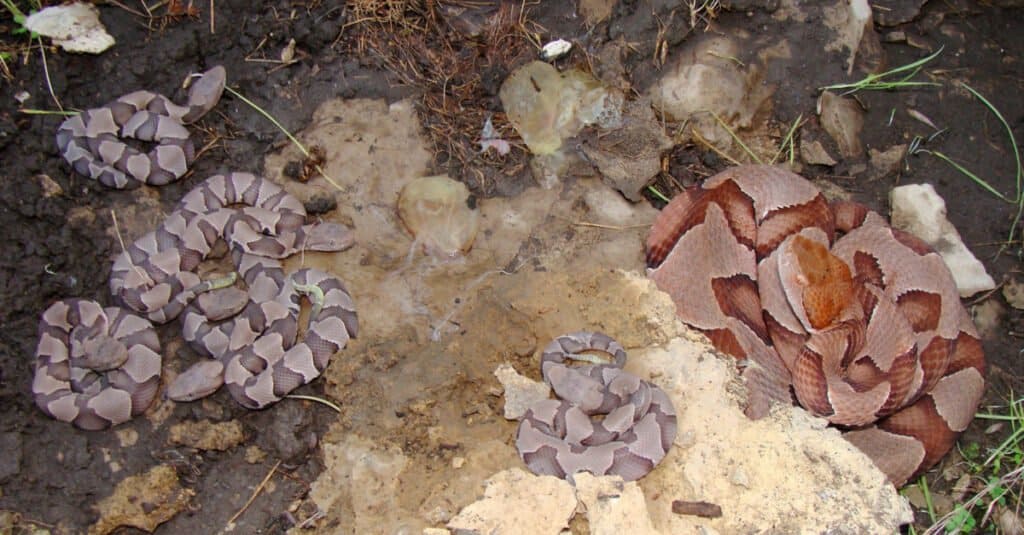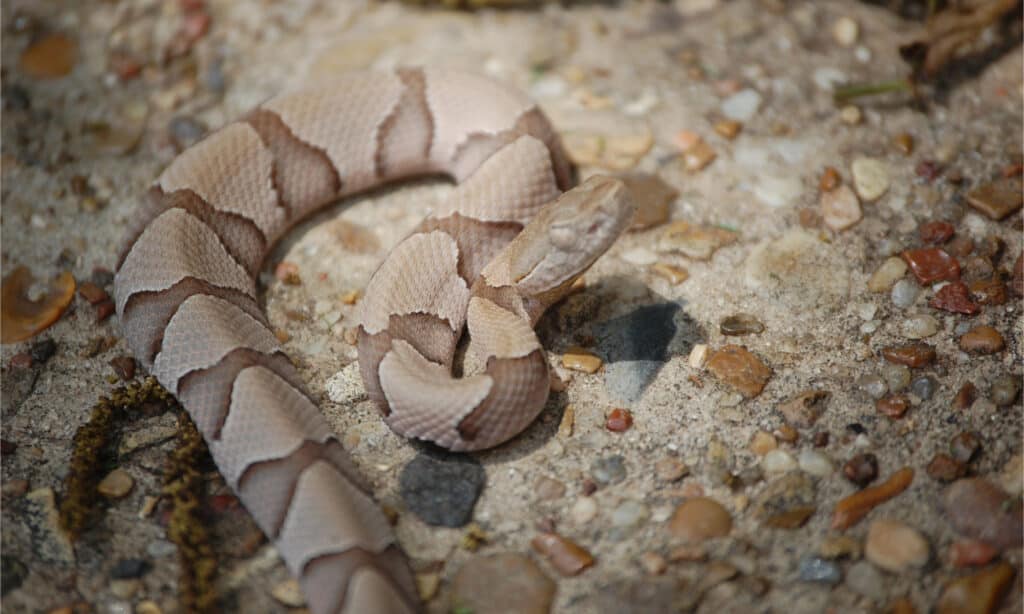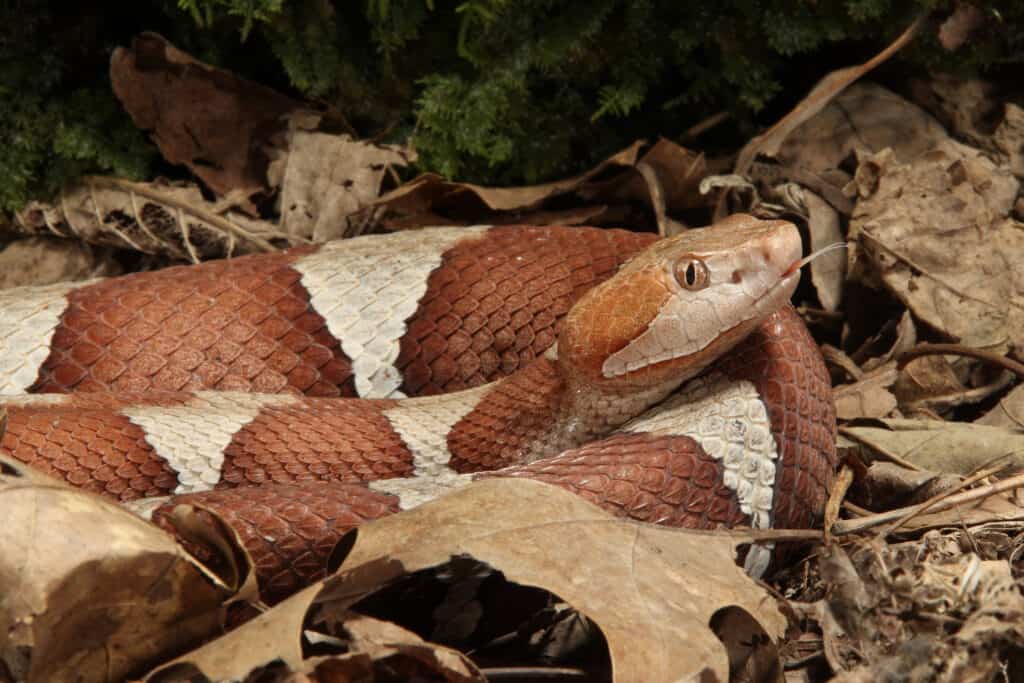Copperheads are widespread across the southeastern U.S. They are also one of the most studied snakes, which is great as we get to learn a lot about how unique they are. Like all pit vipers, they have pit organs that give them infrared vision.
Baby copperheads are just as popular and possibly even more unique than their parents. Their mode of hunting, venom levels, and looks are just some of their unique features. If you’ve heard that baby copperheads are more venomous than adults and would like to find out how true this is, as well as other interesting facts about them, this article has got you covered.
Baby Copperhead Season

Although copperheads have two mating seasons, they only have one birthing season.
©Matt Jeppson/Shutterstock.com
Copperheads reach sexual maturity when they measure about 2 feet and are about 4 years old. They are known to mate twice a year. The first mating season is in spring, from February to early May, and the second is from August to October. The first mating season is right after snakes emerge from hibernation. If these snakes mate just before hibernation, female copperheads can store the sperm and delay fertilization of their eggs till after hibernation. This way, they are all born around the same season.
Male copperheads go after females in a bid to court them or earn their permission to mate. They fight other male snakes for breeding rights in the area. Only the strongest males win, thus preserving the strength of their species. However, even if a male is successful, the female may reject him. In such an instance, she will wave her tail to keep him away.
Female copperheads may challenge prospective mates to battle, and losers or those who refuse to battle will be rejected. Baby copperheads season starts around August or September when baby copperheads are born. It is also important to know that copperheads can mate asexually.
Newborn Copperheads

Copperheads have around 2 to 18 young ones, and their babies measure 8 to 9 inches at birth.
©Daulton Moore/Shutterstock.com
Since copperheads are ovoviviparous, they do not lay eggs. Copperheads have around 2 to 18 young ones, measuring 8 to 9 inches at birth. They look just like adult copperheads but have brightly colored tail tips. The tips of their tails could be red, yellow, or neon.
Research shows that they use their tails for hunting. Recall that adult copperheads are stalk and ambush hunters. Babies, however, are lure and attack hunters; they distract and attract their unsuspecting prey with their tails. When baby copperheads’ prey comes close enough, they kill and eat them. Adult copperheads eat a lot of small mammals, but baby copperheads eat a lot of caterpillars, grubs, and toads.
At What Age Do Baby Copperheads Become Venomous?
Baby copperheads are born venomous. They do not have to attain a specific age to become venomous. They are also born with solenoglyphous fangs (hinged, hypodermic needle) and know how to use them.
Is Baby Copperhead Venom More Dangerous Than Adults?
Baby copperheads and adults have the same venom. Their venom isn’t any more different or dangerous than adults. If anything, they have less venom than adults because their venom glands are smaller. On average, an adult copperhead injects only 26 mg of venom, despite having up to 85 mg in its reserve.
Copperhead Venom

Copperheads’ hemotoxic venom can damage tissue and attack blood cells.
©Dennis W Donohue/Shutterstock.com
Copperheads have hemotoxic venom, which damages tissue and attacks blood cells. Their venom helps them immobilize prey for easier swallowing. It may also help break down their prey during digestion. Copperheads are also known to have extremely painful bites, despite their low fatality rate. They have a maximum venom yield of 85mg and need about 80 to 100 mg to kill a human.
Since 0.01% of copperhead bites are fatal in America and an average of 2,920 bites are recorded each year, we can correctly estimate an average of 1 death every 4 years. This is rather low considering that copperheads bite more people than any other snake in the USA. However, it is important to know that every fatality is regrettable and can be prevented, as there are antivenom shots for copperhead bites that neutralize the effects of their venom.
Are Baby Copperheads Aggressive?

Like adults, baby copperheads aren’t aggressive.
©Daulton Moore/Shutterstock.com
Copperheads aren’t aggressive as adults or as babies. Like most snakes, they want humans to leave them alone and are even solitary except when they mate. When these snakes sense humans approaching, they go very still so they can blend into their surroundings and not be seen. Most times, humans do not see them and go ahead to step on or near them, which scares them and makes them bite. However, a large number of their bites are dry or warning bites.
What To Do If You Spot A Baby Copperhead Snake
If you spot a baby copperhead, do not go near it. Treat them as you would an adult copperhead, and remember that if the snakes have just been born, the mother may not be too far away. However, if it is apparent that they have been abandoned and are injured, contact your local veterinary center so they can safely retrieve and care for the snake.
Except you are trained, picking up a baby copperhead- or any snake for that matter- isn’t a good idea. Snakes are naturally afraid of humans and will consider such close contact a declaration of war. Remember that most snake bites occur due to humans accidentally or mistakenly threatening snakes.
What To Do If You Get Bitten By A Baby Copperhead Snake
If a copperhead or any other snake has bitten you, treat it as an emergency irrespective of the snake’s species or age. If you’re outside your home, make sure not to panic. First, walk (not run) as far away from the snake as you can, aiming for any phone. If you already have your mobile phone, you still need to get as far away from the snake as possible.
It is important to walk and not run because movements aid the circulation of the venom. Once you can get a phone, call your local poison control center and then sit calm and wait for help. Do not attempt first aid treatments such as tying a tourniquet or sucking the venom out.
The photo featured at the top of this post is © Breck P. Kent/Shutterstock.com
Discover the "Monster" Snake 5X Bigger than an Anaconda
Every day A-Z Animals sends out some of the most incredible facts in the world from our free newsletter. Want to discover the 10 most beautiful snakes in the world, a "snake island" where you're never more than 3 feet from danger, or a "monster" snake 5X larger than an anaconda? Then sign up right now and you'll start receiving our daily newsletter absolutely free.
Thank you for reading! Have some feedback for us? Contact the AZ Animals editorial team.






